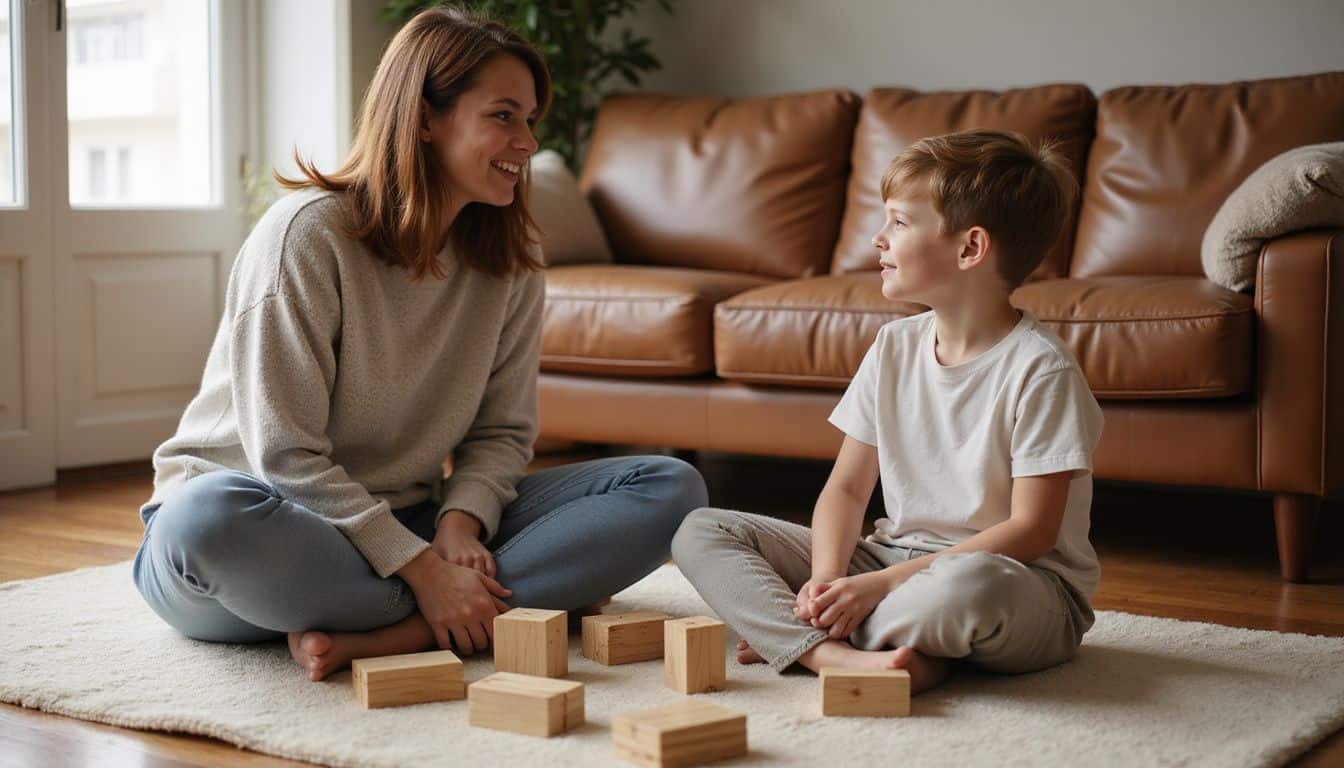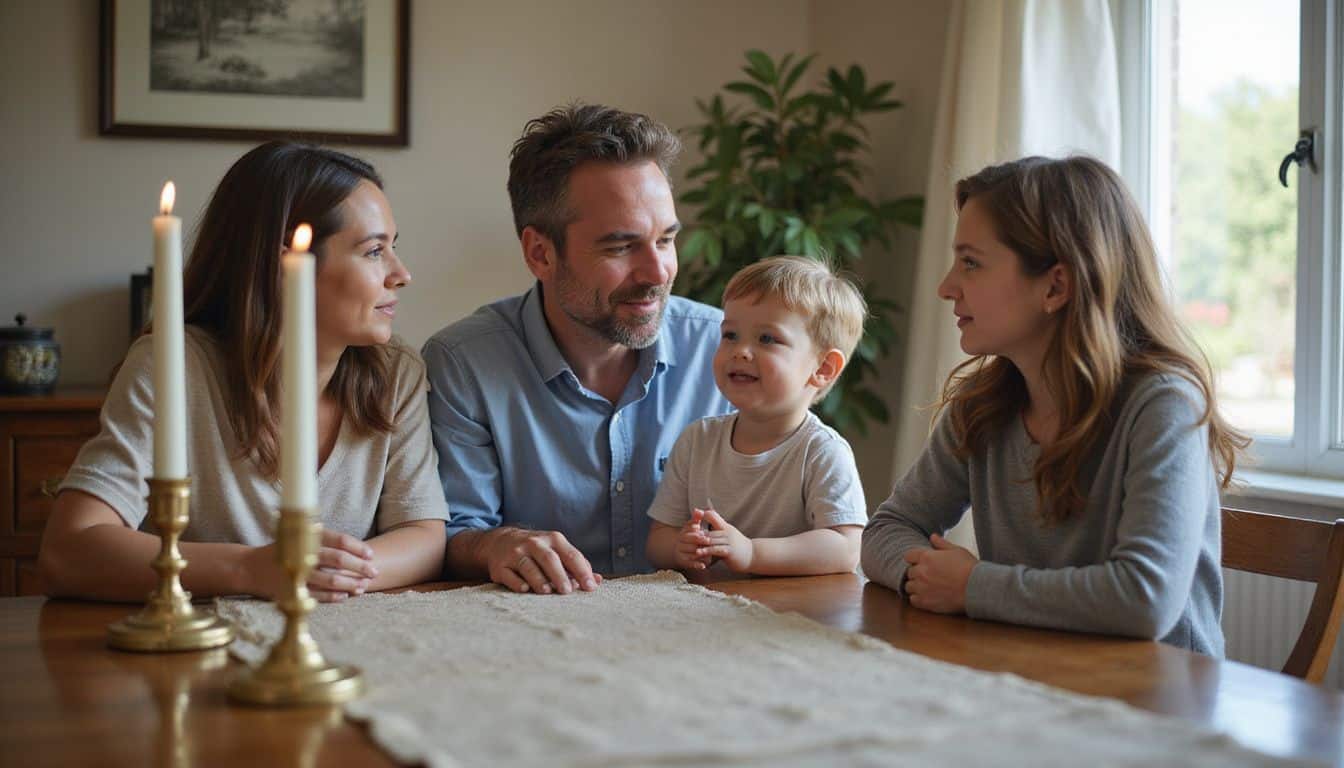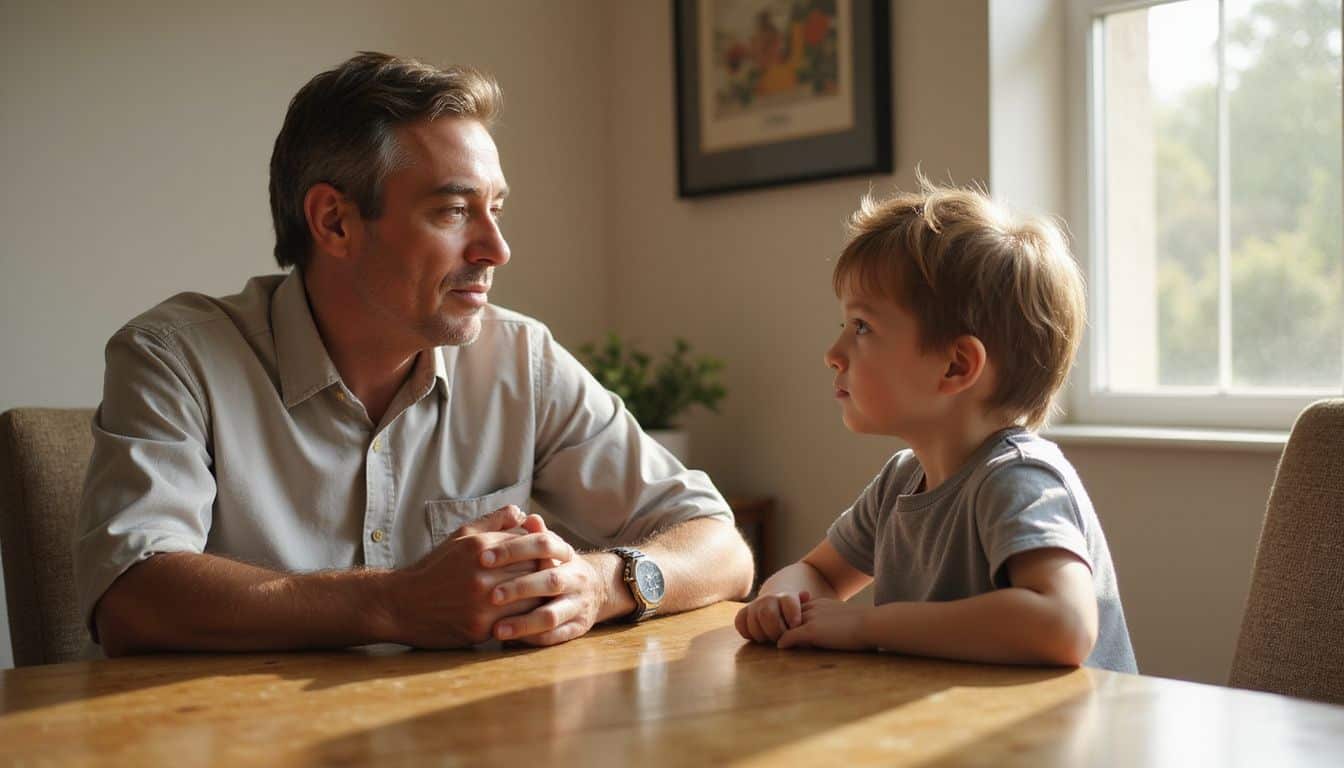Many parents struggle with children who stay quiet in important moments, missing chances to express their needs or stand up for themselves. Research shows that kids who learn self-advocacy skills early develop stronger confidence and better problem-solving abilities throughout their lives.
This guide reveals five proven strategies for teaching kids to speak up, helping you build your child’s assertiveness while maintaining respect for others. Your child’s voice matters, and these methods will help them find it.
Key Takeaways
Children who learn self-advocacy skills early develop stronger confidence, better problem-solving abilities, and improved academic performance throughout their lives.
Parents should avoid labeling children as “shy” because these labels become self-fulfilling prophecies that limit communication growth and confidence building.
Role-playing realistic scenarios like ordering food or talking to teachers helps kids practice speaking skills safely before facing real-world situations.
The CALM strategy teaches assertive communication: Chill, Assert needs respectfully, Look Strong with good posture, and Mean It with firm tone.
Collaborating with teachers and mentors creates powerful support systems that reinforce confidence-building work across home and school environments effectively.
Table of Contents
Why is it important for kids to speak up?

Building on the foundation we’ve established, teaching children to speak up is crucial for their future success and well-being.
Speaking up is a vital skill for solving problems, addressing injustice, and creating change in the world. Children who learn to express their thoughts and feelings develop stronger self-confidence and resilience that carries them through life’s challenges.
Early self-advocacy builds lifelong skills for relationships, work, and community involvement, giving kids the tools they need to thrive as teens and adults. I’ve seen firsthand how my daughter transformed from a quiet preschooler into a confident young person who stands up for herself and others after we practiced these techniques together.
Empowering children to use their voices reinforces their strength and agency, helping them understand their own self-worth and identity. Kids who speak up can better handle peer pressure, set healthy boundaries, and develop essential conflict resolution abilities.
They learn to make decisions independently while building a strong sense of belonging in their communities. Children who advocate for themselves also show improved body language, reduced anger issues, and better goal-setting skills.
This confidence building extends beyond childhood, protecting them from situations where they might be bullied or face cyberbullying. Teaching kids to speak up creates ethical young people who become positive role models for others, breaking harmful social norms and fostering healthier relationships throughout their parenting journey and beyond.
Sometimes children need support in serious situations, including legal action against juvenile centers, making their ability to communicate even more critical.
Strategies to Help Kids Build Confidence

Building your child’s confidence takes time, patience, and the right approach. These proven methods help children develop strong self-esteem while learning to express themselves clearly and respectfully.
How can I encourage open communication at home?

Open communication starts with creating a safe space where your child feels heard and valued. Your family conversations become the foundation for building your child’s confidence in expressing thoughts and feelings.
- Ask open-ended questions during daily activities like dinner or car rides to encourage thoughtful conversations and stimulate thinking. Questions like “What was the best part of your day?” help children share more than simple yes or no answers.
- Practice turn-taking in conversations to teach patience and attentiveness at home. Give each family member time to speak without interruptions, showing respect for everyone’s voice and experience.
- Provide opportunities for children to speak at home, including allowing disagreement in family discussions. Let your child express different opinions safely, which builds their self-esteem and decision-making skills.
- Ask questions to stimulate thinking and encourage assertion of beliefs, even under peer pressure. Help your child practice standing up for their values through regular family talks about making decisions.
- Involve children in family decisions and validate their opinions to build confidence. Include them in choices about weekend activities or family rules, showing their thoughts matter.
- Create regular family meetings where everyone shares thoughts and concerns. These meetings give children practice speaking up in a supportive environment before facing real-world situations.
- Listen without immediately offering solutions or judgment when your child shares problems. Sometimes children need to process their thoughts out loud rather than receive advice right away.
- Share age-appropriate stories about times you had to speak up or overcome shyness. Your personal examples show children that taking risks with communication leads to positive outcomes.
- Encourage your child to express feelings through different methods like drawing, writing, or role-playing. Some children find it easier to communicate through creative activities before using words.
For additional resources on child safety and communication, visit RAINN. These home strategies prepare your child for practicing communication skills through role-playing scenarios.
Why should I avoid labeling my child as “shy”?

Calling your child “shy” can stick in their mind and shape how they see themselves. The words spoken over a child affect their self-perception and communication skills for years to come.
Labels like “shy” often become self-fulfilling prophecies. Your daughter might start believing she can’t speak up, even in situations where children feel pressured to perform.
This negative labeling reinforces quiet behavior instead of helping kids grow.
Shyness shows up in different ways, from anxiety about unknown responses to needing time to feel comfortable. Instead of saying “she’s shy,” try neutral phrases like “not feeling talkative right now.” This approach encourages communication without creating negative self-talk.
I’ve seen kids transform their confidence once parents stopped using the shy label. Your child’s silence doesn’t define who they are, it just describes how they feel in that moment.
What are some benefits of self-advocacy for kids?

Self-advocacy gives kids powerful tools that help them succeed in every part of life. Children who speak up for themselves make better decisions at school, build stronger friendships, and feel more confident about who they are.
These skills help kids perform better in their classes, solve problems on their own, and stay safe in different situations. My daughter learned to ask her teacher for extra help in math, and her grades improved right away.
Kids who practice self-advocacy develop independence that serves them well as they grow up. They learn to manage their emotions better and build a strong sense of identity. These children improve their academic performance, strengthen relationships with friends and family, and gain confidence as their authentic selves.
Self-advocacy teaches kids to stand up for what they need while respecting others, creating a foundation for lifelong success.
Practicing and Role-Playing

Role-playing creates a safe space where kids can practice speaking up before facing real-world situations, building their confidence through fun scenarios that feel like games rather than lessons… and there’s so much more to discover about making these practice sessions truly effective.
How do I simulate real-life speaking scenarios for my child?

Role-play activities give kids a safe space to practice speaking skills before facing real situations. These practice sessions build confidence and teach children how to express themselves clearly.
- Create realistic scenarios that match your child’s daily life, such as ordering food at restaurants, talking to doctors during checkups, or asking teachers questions about homework assignments.
- Assign specific roles during practice sessions where you play the adult figure while your child practices being themselves in different situations.
- Use role-play cards and scripts as visual aids to help guide conversations and give your child concrete examples of what to say.
- Start with simple interactions like greeting neighbors or thanking store clerks, then progress to more complex situations as confidence grows.
- Provide clear instructions before each practice session and offer gentle feedback afterward to help your child improve their communication skills.
- Simulate peer interactions by practicing how to handle disagreements, ask friends to play, or stand up to bullying situations.
- Adjust scenarios for children with learning disabilities by offering more structured support and breaking conversations into smaller, manageable parts.
- Practice phone conversations by calling family members or pretending to schedule appointments with different service providers.
- Incorporate reflection time after each role-play session where your child can share what felt easy, what seemed challenging, and what they learned.
What is assertive yet respectful communication for kids?

Assertive communication teaches kids to express their needs clearly without hurting others. This balanced approach sits between passive and aggressive styles, much like different animals show different behaviors.
Kids learn to use “I messages” that focus on their feelings instead of blaming others. For example, saying “I feel upset when my toy gets taken” works better than “You always steal my things.” This technique helps children resolve conflicts while maintaining friendships.
Assertive children know how to stand up for themselves and others without being hurtful or mean.
The CALM strategy gives kids a simple framework for speaking up confidently. Children first Chill by taking deep breaths and naming their emotions. Then they Assert themselves using respectful phrases like “I need” or “I would like.” Looking Strong means standing tall with good eye contact and confident body language.
Finally, kids Mean It by using a firm but calm tone of voice. Parents can model this behavior daily, showing children how confident communication looks in real situations. My own daughter struggled with playground conflicts until we practiced these techniques at home, and I noticed her confidence grow as she learned to express herself clearly.
Understanding different parenting approaches can help you find the right balance for teaching these skills.
Supporting Kids in Real Situations

Supporting your child in real-world speaking situations requires a team approach that includes teachers, coaches, and other trusted adults who can reinforce the confidence-building work you do at home… and there are specific ways to make this collaboration work effectively for your child’s success.
How can I collaborate with teachers and mentors to support my child?

Building strong partnerships with teachers and mentors creates a powerful support system for your child’s growth. These relationships help your child feel confident speaking up in school settings.
- Attend school meetings and workshops regularly to stay informed about your child’s development and learn new ways to support their communication skills at home.
- Establish a positive relationship with teachers by sharing insights about your child’s personality, strengths, and areas where they need extra encouragement to speak up.
- Enhance communication with teachers by scheduling regular check-ins to discuss your child’s progress and share observations about their confidence levels at home.
- Collaborate with teachers to secure necessary accommodations that help your child feel comfortable participating in class discussions and group activities.
- Identify a trusted adult at school, such as a counselor or favorite teacher, who your child can turn to when they need support or encouragement.
- Share personal anecdotes of self-advocacy with teachers and mentors to help them understand your family’s values and motivate your child’s growth.
- Encourage teachers to provide feedback on your child’s self-advocacy efforts so you can celebrate progress and address challenges together.
- Advocate for positive changes in the learning environment by discussing classroom dynamics that might help shy children feel more comfortable participating.
What are some small steps to help kids start speaking up?

Small steps create big changes in your child’s confidence. These simple actions help kids practice speaking up every day.
- Let your child order their own food at restaurants. This everyday situation gives them practice expressing their needs clearly. Start with simple orders and praise their efforts.
- Encourage responses to store clerks and cashiers. These brief interactions build comfort with strangers. Your child learns that speaking up is normal and safe.
- Ask for their opinions during family discussions. Value what they say about dinner plans, weekend activities, or family decisions. This shows their voice matters.
- Practice raising hands in pretend classroom settings. Role-play school scenarios where they ask questions or share answers. This builds muscle memory for real situations.
- Celebrate when they ask for help with homework or chores. Acknowledge these moments with descriptive praise like “You spoke up clearly about what you needed.” Small wins build bigger confidence.
- Script simple phrases for common situations. Teach them to say “May I speak with my teacher?” or “I need help with this problem.” Having ready words makes speaking easier.
- Start conversations about their day and feelings. Ask open questions that require more than yes or no answers. This develops their ability to express thoughts fully.
- Encourage them to speak up about preferences during playdates. Let them choose activities or express when they want to try something different. Peer interactions teach valuable social skills.
Working with teachers and mentors amplifies these home efforts and creates consistent support across all environments.
How Will Teaching Kids to Speak Up Evolve in 2025?

Teaching kids to speak up will change significantly in 2025, with daily practice becoming essential for building confidence. Sierra Angelina Willow and researchers like Sarah Hayes from UNSW are developing new approaches that combine digital resources with community support.
Activity sheets released on August 9, 2024, now include interactive elements that make self-advocacy practice enjoyable rather than tedious. Descriptive praise techniques will replace generic compliments, helping children understand exactly what speaking behaviors to repeat.
Schools and families will work together more closely, creating structured support systems for children with learning disabilities. Professor Susan Moore’s research shows that teaching children about rights and responsibilities together produces stronger advocates.
New workbooks and digital tools will give parents specific ways to practice real-world scenarios at home. Chambers (2024) and Ucar et al. (2024) research confirms that children who learn self-advocacy skills early show better academic and social outcomes throughout their lives.
People Also Ask
What are the main confidence strategies for teaching kids to speak up?
The five essential strategies include active listening practice, role-playing exercises, and creating safe spaces for expression. These methods help children build communication skills gradually while developing self-assurance in various social situations.
How can parents help shy children gain speaking confidence?
Start with small, comfortable conversations at home and gradually introduce new speaking opportunities. Praise their efforts, not just results, to build lasting confidence.
What role does practice play in developing children’s speaking abilities?
Regular practice through games, storytelling, and family discussions strengthens speaking muscles like physical exercise. Children who practice speaking daily show faster improvement in confidence and clarity.
When should parents seek additional help for children who struggle to speak up?
If a child consistently avoids speaking after age four or shows extreme anxiety during conversations, consider consulting a speech therapist or child psychologist.
References
https://www.happilyfamily.com/how-kids-learn-to-speak-for-themselves/
https://www.southernpediatrictherapy.com/resources/5-ways-to-build-your-childs-social-confidence
https://www.understood.org/en/articles/10-ways-to-help-shy-children-self-advocate
https://www.as-they-grow.com/how-to-help-a-shy-child (2025-07-11)
https://www.stepaheadaba.com/blog/how-to-use-role-playing-to-teach-social-skills-at-home (2025-06-25)
https://www.planetspark.in/public-speaking/how-to-be-confident-tips-for-kids (2025-07-15)
https://www.reframeparenting.com/blog/self-advocacy-teaching-your-child-to-speak-up-at-school (2025-02-28)
https://www.edutopia.org/article/teaching-better-public-speaking/
